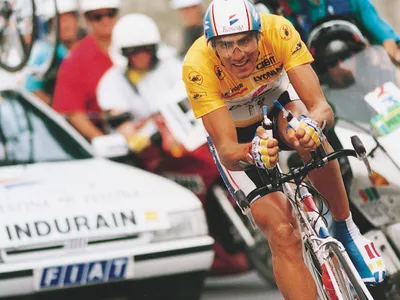
Tour de France Uncovered: Legendary History, Iconic Champions, and Jaw-Dropping Facts…Read More…
Each summer, the eyes of the sporting world turn to the roads of France, where a spectacular blend of endurance, strategy, and drama unfolds — the Tour de France, the most prestigious cycling race on the planet. But beyond the yellow jersey and the Champs-Élysées finish lies a fascinating tale of over a century of athletic triumph, national pride, and at times, controversy. Here’s a deep dive into the race’s rich history, unforgettable champions, and the jaw-dropping facts that make the Tour de France a global phenomenon.
A Race Born from Rivalry and Print
The origins of the Tour de France can be traced back to 1903, and not from a sporting body — but a newspaper war. The French sports daily L’Auto, struggling to outpace its competitor Le Vélo, came up with a bold idea: to organize a grueling multi-day cycling race that would capture the imagination of the nation. Under the guidance of editor Henri Desgrange, the first Tour set off on July 1, 1903, covering six stages and nearly 2,500 kilometers.
Only 60 riders entered that inaugural race, and just 21 finished. Maurice Garin, a chimney sweep turned cyclist, claimed victory and became the first man to etch his name into the annals of Tour history.
From Local Event to Global Icon
Over time, the Tour grew from a national curiosity to an international sensation. From the Alps to the Pyrenees, through lavender fields and cobbled streets, the route evolved to challenge even the hardiest cyclists. World Wars paused the race, but the Tour always returned, stronger and more symbolic than before.
By the 1950s and 60s, riders like Jacques Anquetil and Raymond Poulidor captivated French fans. But it was the rise of international stars like Eddy Merckx — known as “The Cannibal” for his ruthless dominance — that gave the Tour its global footing.
Merckx won five Tours (1969–1974), matching the record later equaled by legends Bernard Hinault, Miguel Induráin, and Jacques Anquetil.
Lance Armstrong and the Era of Controversy
Perhaps no rider is more infamous than Lance Armstrong, who won seven consecutive Tours from 1999 to 2005 — only to be stripped of them after a dramatic fall from grace. A long-denied doping scandal finally exploded in 2012, when the U.S. Anti-Doping Agency exposed an elaborate scheme of performance-enhancing drugs and systemic deception.
Armstrong’s saga highlighted a dark chapter in cycling history but also sparked an era of reforms and tighter anti-doping regulations. The sport, while still recovering its image, is now more transparent than ever.
Modern-Day Champions: A New Generation Rises
In recent years, the Tour de France has ushered in a new generation of superstars. Chris Froome of Team Sky (now Ineos Grenadiers) dominated the 2010s with four wins. But the spotlight has since shifted to younger talents like Tadej Pogačar, who won back-to-back Tours in 2020 and 2021 at just 21 and 22 years old, and Jonas Vingegaard, the Danish dynamo who claimed victory in 2022 and 2023 with precision and power.
These riders, supported by powerful teams and guided by sports science, represent a new age of cycling that marries tradition with innovation.
Stunning Tour de France Facts You Might Not Know
- Over 3,400 km of Pain and Glory: Each Tour covers approximately 3,400 kilometers (2,100 miles) over 21 stages, including flat sprints, mountain climbs, time trials, and everything in between.
- The Yellow Jersey (Maillot Jaune): Introduced in 1919, the iconic yellow jersey is awarded to the overall leader in the general classification. Yellow was chosen to match the color of L’Auto, the original race organizer’s newspaper.
- Fastest Tour Ever: The fastest edition on record was in 2022, when Jonas Vingegaard averaged 42.03 km/h over the full course.
- Most Stage Wins: Belgian legend Eddy Merckx and Mark Cavendish of Britain are tied with 34 stage wins apiece — a record many consider unbeatable.
- Spectator Frenzy: The Tour attracts an estimated 12 million roadside spectators each year, making it one of the most attended annual sporting events in the world — all free to watch.
- An International Affair: Though it starts in France, recent Tours have launched from locations as diverse as Belgium, the Netherlands, the UK, Denmark, and this year, Italy.
- A Grueling Calorie Burn: Riders burn an average of 5,000–6,000 calories per day. That’s about 25 Big Macs daily just to stay fueled!
The Cultural and Economic Impact
More than just a race, the Tour de France is a traveling festival. It brings with it caravans, local celebrations, global TV audiences, and a surge in tourism for rural French towns. For many regions, hosting a Tour stage is an honor that boosts local pride and economy.
Moreover, the race has long inspired literature, documentaries, films, and even fashion. From its romanticized early days of suffering and solo battles against nature to today’s high-tech spectacle of team strategy and split-second decisions, the Tour continues to evolve without losing its soul.
Looking Ahead
As the 2025 edition of the Tour de France approaches, anticipation builds for new rivalries, surprising upsets, and the same breathtaking scenery that has captivated fans for more than a century. With rising talents like Remco Evenepoel and seasoned veterans still hungry for glory, the Tour promises drama on every mountain pass and across every finish line.
In a world where sporting events come and go, the Tour de France remains a fixture of excellence, pain, perseverance, and joy. It’s not just a race. It’s a celebration of human endurance — a living, pedaling legend.
Vive le Tour!
Leave a Reply